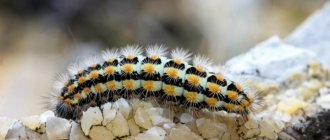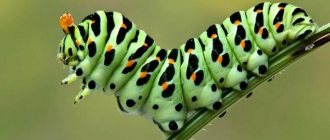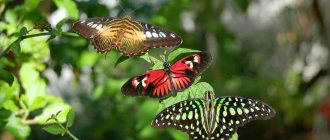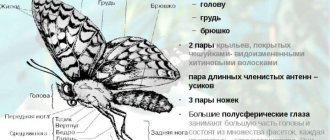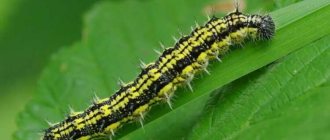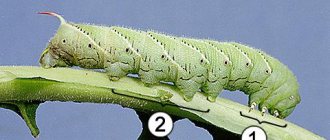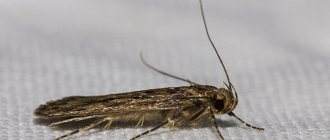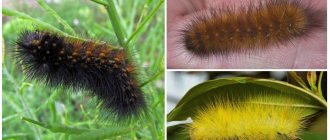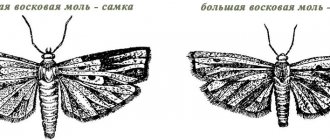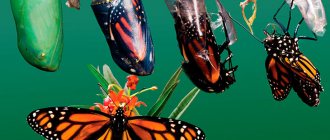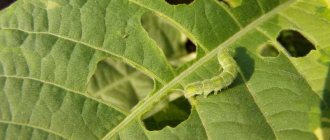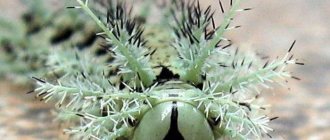Butterflies are a true miracle of nature. People call them fresh flowers and admire and adore them. How does the transformation from a caterpillar into a butterfly occur - stages of development.
Even small children know that a clumsy caterpillar turns into a gentle and graceful butterfly. But the details of the transformation process may surprise even adults.
Where do caterpillars come from: the life cycle of butterflies
The female lays eggs after fertilization.
Under favorable conditions, a larva develops inside. The process takes from 2 to 14 days. Upon completion, they gnaw through the rim of the eggs and crawl out. This is how the caterpillar appears. The size of the first stage larvae is about 1 mm. They are born with a huge appetite, eat a lot, and grow quickly. As they grow older, they undergo an average of 4 molts, but there are species that are reborn up to 16 times. The duration of this cycle depends on the type of insect and habitat. In our area, females manage to give birth to two generations; the larva develops in about 6 weeks.
Caterpillars live under the bark of trees, in cereals, grains, and under the leaves of various plants. They feed on juices and gain strength. At the imago stage, the moth lives from several days to 20 days. During this time, it either does not eat anything or feeds on plant nectar, juices of berries, and fruits.
Interesting!
In northern latitudes, the larva does not have time to go through the full development cycle in one summer; it remains to winter in this form and continues to develop with the onset of warmer weather. Northern species are able to withstand frosts below -70 degrees Celsius. In Greenland and Canada, the transformation of a caterpillar into a butterfly lasts 7-14 years.
Finally, the larva forms a cocoon from independently produced threads and turns into a pupa. It clings to the tree and leaves with its paws and freezes. The most mysterious phenomenon begins - the transformation into a moth.
Life cycle of butterflies
Order of butterflies, or Lepidoptera
Lepidoptera are the largest group of insects from the phylum arthropods. A characteristic feature of all representatives of the order of butterflies is the scaly multi-colored cover of the body and wings. These scales are nothing more than modified hairs. They have different colors and can create complex and bizarre patterns.
We invite you to familiarize yourself with Stride Plus for dogs: composition, side effects, instructions for use, analogues
Another identifying feature of the order of butterflies is the sucking mouthparts in the form of a long tubular proboscis. To eat, the butterfly extends its long proboscis, plunges it deep into the flower and sucks up the nectar.
The main source of food for the order of butterflies is the nectar of flowers, so they are considered the main pollinators of flowering plants. There is an opinion that with the advent of flowers on Earth, butterflies appeared.
Today there are about 150,000 species of squamates that live on all continents except Antarctica. Tropical areas are especially rich in brightly colored butterflies. In addition to butterflies, there are several other similar orders of insects: Homoptera, Diptera, fleas. We invite you to get acquainted with the main representatives of each squad:
- Homoptera. There are more than 30,000 species. These include cicadas, whiteflies, psyllids, scale insects, aphids, gall midges, and scale insects. All of them belong to sucking insects that feed on plant sap. They have a piercing-sucking mouth like a proboscis. Why are they called Homoptera? Nature has endowed them with two pairs of transparent wings - front and rear.
- Diptera. This order includes a million species. They arose more than 100 million years ago. Everyone is familiar with mosquito bites and annoying flies. They have a front pair of wings. Their hind wings can be called small appendages - halteres, which maintain balance during flight.
- Fleas. There are more than 1000 species. These are small insects without wings and with flattened sides. The size of fleas is from 1 to 5 mm. They have a large abdomen and legs, but a small chest and head. They have a slippery and smooth body dotted with bristles and hairs. All this is to make it easier to move through the fur of animals where fleas live. An adult flea is a bloodsucker that parasitizes birds and mammals.
What is metamorphosis and why is it needed?
Metamorphosis, i.e. a life cycle with a series of successive transformations is a very successful acquisition in the struggle for existence. Therefore, it is widespread in nature and is found not only in insects, but also in other living organisms. Metamorphosis allows different stages of the same species to avoid competition among themselves for food and habitat. After all, the larva eats different food and lives in a different place; there is no competition between the larvae and adults. Caterpillars gnaw leaves, adult butterflies calmly feed on flowers - and no one bothers anyone. Through metamorphosis, the same species simultaneously occupies several ecological niches (feeding on both leaves and flowers in the case of butterflies), which also increases the species' chances of survival in an ever-changing environment. After the next change, at least one of the stages will survive, which means the entire species will survive and continue to exist.
Methods of dealing with caterpillars
The appearance of caterpillars on plants does not bode well. These voracious insects can cause serious harm to a crop and even cause its death. In this case, at the first signs of their vital activity, it is necessary to take urgent measures to save the plants.
The following insecticides can be used to control caterpillars:
- Bitoxibacillin;
- Iskra M;
- Inta-vir;
- Senpai;
- Monsoon;
- Lepidocide.
To prevent damage, you can use decoctions based on tobacco leaves, chamomile, onion peels, tomato tops, and yarrow. The smell of these plants can scare off flying individuals, and they will not be able to lay eggs.
Butterfly breeding
The shape and color of the wings are of great importance when breeding butterflies. Some species are sexually dimorphic: males and females differ in appearance, which makes it easier for lepidopterans to find a partner. Other species use pheromones to attract mates. Depending on the species, either males or females can attract a partner in this way. The mating dance is also characteristic of butterflies.
Mating occurs on plant leaves or the ground. It can last from 20 minutes to several hours. By fertilizing a female, the male not only transfers his seed, but also components that are useful during pregnancy. Some species have an interesting feature: after fertilization, a chitinous appendage appears on the female’s abdomen, which eliminates the possibility of repeated mating.
The mating process of the heliconid charitonia is interesting. The female begins to emit pheromones several hours before emerging from the pupa. Males flock to her and begin to fight with each other. The winning male fertilizes the pouch as it emerges from the pupa.
After fertilization, the female lays eggs. This is how butterflies are born. In the tropics, some species can produce up to three generations in one year.
Take advantage of these lessons
- Any trouble that happens to us makes us stronger. Learn to benefit from them.
- Our strength is in optimism. Use positive thinking and keep faith that things will get better.
- Don't give up, even if you really want to do it. Be purposeful and persistent.
- Any difficult circumstances can be analyzed and benefited from for subsequent personal growth.
- Don't focus on the bad. Remain in the thought that the darkest night is before the dawn.
- Get out of your comfort zone, remember that there are other horizons and next stages of development ahead. You are created for something more!
- Your mindset attracts certain events and people into your life. Positive thoughts lead to positive events. Your attitude towards life determines its level and points of development. All in your hands.
leave a comment
Stages of butterfly development
Butterflies are insects with a full cycle of transformation, that is, they go through all stages of development:
- egg;
- larva (caterpillar);
- chrysalis;
- imago (adult).
Each stage of the transformation of a caterpillar into a butterfly takes time and has its own characteristics.
Egg
First, the adult butterfly lays an egg and thereby gives rise to a new life. Depending on the type, eggs can be round, oval, cylindrical, conical, flattened and even bottle-shaped. Eggs differ not only in shape, but also in color (usually they are white with a green tint, but other colors are not so rare - brown, red, blue, etc.).
The eggs are covered with a dense hard shell - the chorion. The embryo located under the chorion is equipped with a supply of nutrients, very similar to the well-known egg yolk. It is by this that the two main life forms of lepidopteran eggs are distinguished. Eggs of the first group are poor in yolk. Those species of butterflies that lay such eggs develop inactive and weak caterpillars. Outwardly, they look like tadpoles - a huge head and a thin, thin body. Caterpillars of such species must begin to feed immediately after emerging from the egg, only after which they acquire fully plump proportions. That is why butterflies of these species lay eggs on a food plant - on leaves, stems or branches. Eggs placed on plants are typical for diurnal butterflies, hawk moths, and many cutworms (especially lancets).
In other butterflies, eggs are rich in yolk and provide the development of strong and active caterpillars. Having left the egg shell, these caterpillars immediately begin to crawl away and are able to cover sometimes quite significant distances for them before finding suitable food. Therefore, butterflies that lay such eggs do not need to worry too much about their placement - they lay them wherever they need to. Thinworms, for example, scatter eggs on the ground in bulk right on the fly. In addition to slender moths, this method is typical for bagworms, glassworts, many moths, cocoon moths and bear moths.
There are also lepidoptera that try to bury their eggs in the ground (some cutworms).
The number of eggs in a clutch also depends on the species and sometimes reaches 1000 or more, however, not all survive to the adult stage - this depends on factors such as temperature and humidity. In addition, butterfly eggs have no enemies from the insect world.
The average duration of the egg stage is 8-15 days, but in some species the eggs overwinter and this stage lasts months.
From chrysalis to butterfly
While in chrysalis form, caterpillars are most vulnerable. They are motionless and cannot protect themselves from predators - birds and insects. The only thing that saves them is that the cocoon usually looks unpretentious and does not stand out much from the background of the environment.
Despite the fact that no movements are noticeable from the outside, many complex processes are taking place inside the cocoon at this time. The transformation from a larva to an adult (imago) in butterflies is called metamorphosis. The final form of the insect is almost completely different from the intermediate one, namely the larva. The only way to recognize the former caterpillar is by its legs.
In the case of butterflies, the caterpillar, once in a cocoon, secretes special substances, under the influence of which its body becomes liquid. In this mass, imaginal discs are preserved, that is, clusters of cells responsible for the formation of new tissues and organs of the future butterfly.
When the metamorphosis is completely completed, the insect secretes enzymes that corrode the shell, after which the butterfly can get out of the cocoon. First the head appears, then the body and legs squeeze through.
Immediately after the butterfly appears, it cannot yet fly. Her wings are wet and curled. The insect crawls higher and sits motionless until the wings straighten, dry and become strong. After this, the butterfly can go on its first flight in order to find a mating partner, then lay eggs and continue the butterfly genus.
How long does the transformation take?
The time that passes from the moment the pupa is formed until the butterfly appears varies significantly depending on the type of insect, climate zone and environmental conditions. In most cases, the rebirth process takes 2-3 weeks. But in some species, the pupa takes much longer to transform into a butterfly. Some species overwinter in pupal form, while others spend several years in this state. For example, in the fluffy cocoon moth, the pupal stage can last up to 8 years. If conditions outside are unfavorable, then the butterfly is in no hurry to appear and waits.
It is difficult to predict what a butterfly will be like based on the appearance of a caterpillar. Sometimes the larva and the adult insect are completely different, and in some cases the similarity is noticeable to the naked eye.
Imago
An adult insect, the imago, emerges from the pupa. The shell of the pupa bursts, and the imago, clinging to the edge of the shell with its feet, while exerting a lot of effort, crawls out.
A newborn butterfly cannot fly yet - its wings are small, as if curled, and wet. The insect necessarily climbs to a vertical elevation, where it remains until it fully spreads its wings. In 2-3 hours, the wings lose their elasticity, harden and acquire their final color. Now you can take your first flight!
The lifespan of an adult varies from several hours to several months, but on average the lifespan of a butterfly is only 2-3 weeks.
VKontakteFacebookOdnoklassnikiMy World Headings Insects 2 comments Post navigation Butterfly Gardens Butterflies Dippers
What a butterfly can teach us: 10 life lessons
- Each of us has our own inner butterfly that waits for the X hour. Each of us has hidden talents and abilities. But conditions are needed so that they can open up and free themselves.
- Any caterpillar can turn into a butterfly tomorrow. Stay optimistic, keep faith in yourself. This is an important condition for transformation.
- Our life consists of different stages, just like the transformation of a butterfly. We go through many changes before we become what we would like to become.
- The desire to fly made the butterfly spread its wings. The need to overcome difficulties stimulates growth.
- By putting in effort now, you will get results tomorrow. Never give up. Your achievements depend on your efforts.
- Enjoy the process, even when you haven't become a butterfly yet. Every stage of your transformation is important, and you need to love the process and not judge yourself too harshly.
- We must see the effort put into someone's success. It’s easy to admire a butterfly, forgetting that it was once an unsightly caterpillar.
- Use all available resources for development. Appreciate each period of your life and transformation, and make the most of it. Everything you have can become a building material for success.
- Don't limit yourself to fears and doubts. Allow yourself to open up and step forward. When you stop feeling joy and satisfaction in life, expect big changes.
- When the situation seems hopeless, think: what was the end for the caterpillar was the beginning for the butterfly.
How to raise an insect
It is possible to create an ideal living environment, but you need to consider a few important things:
- Take a clean food container.
- Fold the paper towel and place it at the bottom of the container.
- Place a regular dry stick or popsicle stick (or two) into the container.
- Carefully place the caterpillar into the container. If it is on a sheet, place the sheet with it.
- If the insect was on the plant and is still eating, store fresh leaves in a container until pupation.
- If the insect sways, it needs to be cleaned. You may need to replace the paper towel from time to time.
- If an insect crawls into a paper towel and disappears, it is probably hiding before pupating.
- Once it pupates, the butterfly will hatch.
The process of turning a larva into an adult butterfly takes a long time, and during most of this period nothing seems to happen. It's even difficult to tell whether the caterpillar is alive or not. The pupal stage can last weeks and often months—many species pupate throughout the winter and hatch the following summer.
Caterpillar food
Almost all caterpillars feed on leaves, but most are very picky. In fact, the insect will only eat one type of leaf, and perhaps only from one particular tree or plant.
If the insect on the plant is what she eats, you can start giving fresh leaves from that plant. Every 2 days you need to give clean, fresh leaves.
To read: What does the taiga tick eat and what dangers does it pose?
If the insect is not found on a plant - for example, on the ground or indoors - it is probably looking for a cozy place where it wants to turn into a pupa. This means the insect is full. It is better to give it a “salad” of leaves collected from trees and plants nearby, the caterpillar may eat them, but if this does not happen, then it is ready to shed its shell and begin to transform into an adult moth or butterfly.
Requirements for growing a butterfly from a caterpillar at home
- Several caterpillars, the brighter and thicker the caterpillars, the more beautiful your butterflies will grow.
- The caterpillar's food is the grass or leaves on which you found the caterpillar.
- A butterfly incubator is an ordinary salofan bag or a three-liter jar.
- The waiting time is usually several weeks and not more than a month.
I will tell my story of how I raised a butterfly from a caterpillar at home (I was in third grade at the time) and the play, explaining your actions.
- I found several identical caterpillars on a bush and collected a dozen. I picked up a full package of these leaves and twigs. So, when you find the caterpillars, you should do the same. If you find a caterpillar on the asphalt and want to turn it into a butterfly, then search the Internet for this caterpillar and find out what plant it eats.
- At home, I made two incubators. I put twigs with leaves in the bag, filling 40% of the bag space. I made holes in the bag with a regular nail to allow air for my pets. Everything is easy here, just repeat. Do not skimp on the number of holes, and place the holes in the middle and top parts of the bag.
- I placed 5 of my caterpillars in one house, 5 in another. And he didn’t throw them in one pile, but spread them out evenly, although I think they might crawl back to their places on their own. Then he tied the bag on top and put it in a place where it was neither dark nor light. No matter what, the sun doesn’t fall on them, but no matter what, they don’t have eternal night. Place it on a corner of a shelf, or a table, or a bedside table, decide for yourself depending on your utility capabilities.
- I constantly looked and observed, the first days they only crawled along the branches and ate leaves. The spectacle was not exciting, boring and not interesting. But we have to wait!
- After about a week there was a lull, when I looked closely I saw that there were no caterpillars! There are cocoons, how they wrapped themselves in them, I don’t even know if I missed this moment. Further, it’s even more boring to watch them, they hang stupidly and that’s it. But we wait further.
- I don’t remember how many days passed there, but I saw the chrysalises and again missed the moment when the cocoon becomes a chrysalis. There was a suspicion that this was happening at night, but in fact, I just rarely looked there. I was interested in the end result.
- One fine morning, around 11 o'clock, I woke up from a strange noise. There was something rustling in the bag. I took a closer look and saw that a yellow butterfly was fluttering there. Surprisingly, it happened. Like a savage, I put my hand in the bag and began to catch it, naturally I scratched the enamel on its wings with my fingers, gently grabbed it by the abdomen and on the balcony released it into the street and it flew away. I returned to my bags and saw a small head bursting out of the pupa into the light of day. She worked hard and for a long time to get out. Sometimes I wanted to reach out and help, but I stopped myself with the thought that I could only do harm. So don’t stop nature from doing its thing, don’t pretend to be surgeons!
- And when the butterfly crawled out before my eyes, I put my hand up and it, having just been born, was not afraid of me at all. I could pick her up and carry her, put her down and pick her up again, she only climbed, but didn’t fly. There was a thought that she was disabled and wouldn’t fly, but still, she flew up and continued to contact me without fear, allowing herself to be picked up (naturally not by the wings). This is just a miracle! I now know that she didn’t fly because her wings needed to dry.
With it, I did the same as with the first butterfly, took it to the balcony and released it, it circled around me for a long time, as if it was saying goodbye or did not want to part, but the smell of freedom gave it new sensations and it fluttered high into the air. That’s what I thought at the time, isn’t it impressive? ?
Unfortunately, the remaining 8 caterpillars died. Nothing hatched from their pupae. Perhaps they did not have enough food supplies, perhaps the conditions were not the same or there were few holes, but most likely it was a bit dry, since they need 80-60% humidity. But in any case, out of 10 caterpillars I have, 2 butterflies were born without much care.
We invite you to read: Advantage for nursing cats
Well, in conclusion, I’ll tell you that you can make money from butterflies (I wrote about this in the article Fear of Retirement), but growing a butterfly at home is not difficult and you don’t need any investment.
How to care for a domestic butterfly?
Keeping butterflies at home begins with preparing a clean, transparent plastic or glass container. It should contain plants as food, soil and twigs on which the caterpillar can crawl and later pupate. Such a container must be covered with a fine mesh or gauze for good ventilation.
It is important to feed the leaves of the tree or bush on which the caterpillar was found. Some species are able to feed on different plants
But the majority prefer one thing - it’s easier for them to die than to eat unfamiliar food
Some species are able to feed on different plants. But the majority prefer one thing - it’s easier for them to die than to eat unfamiliar food.
Leaves must be changed daily. They can be washed and soaked in water - this will be an additional source of moisture for the caterpillar. To keep them fresh throughout the day, they can be placed in tubes of flower water. Larger containers in the form of vases or jars are not a good option. The caterpillar can easily fall into them and die.
The container with the caterpillar should be located in a constant temperature indoors. To maintain moisture, it can be sprayed with a spray bottle.
It is necessary to clean the caterpillar's home every day. For convenience, you can put paper towels at the bottom of the container. Caterpillars are very voracious, so they excrete a lot of excrement. Therefore, paper will make the cleaning task easier.
When the caterpillar reaches the maximum size for its species, the pupation stage will begin. During this period, the caterpillar may change color, eat less, and become lethargic. Over the course of two or three days, the pupation process occurs. A suitable temperature is considered to be 26-28⁰C with humidity up to 90%. It is necessary to periodically irrigate the container for optimal development conditions.
The pupa should be located in a part where there is enough space to spread its wings. It may be necessary to move the leaf or twig to a more favorable point in the container.
It happens that the pupa dies - in this case the cocoon is darker. If you gently bend it and the color does not change, then it is dead.
The adult individual - the imago - appears after a few days, or even weeks. After emerging from the cocoon, the butterfly does not eat for a couple of hours. She spends this time opening and drying her wings. It’s good when there are vertical branches or sticks next to the doll, on which the lepidopterous beauty can sit comfortably.
When is it dangerous to help?
One day a man found a butterfly cocoon and took it home. He decided to observe the transformation process. The cocoon opened, and for several hours in a row this man observed the difficulties the butterfly had to go through in order to get out. She tried to get out through the small hole for quite a long time and suddenly the moment came when it seemed to him that the butterfly had given up and stopped fighting. It looked like she was stuck and completely motionless.
Taking pity on her, the man decided to help her and cut off the cocoon. Thanks to this, the butterfly got out of the cocoon, but its body was swollen like a caterpillar, its wings were small and unopened. The man expected her wings to strengthen and grow and her body to transform, but nothing else happened. The butterfly pitifully dragged its swollen body in a circle, now doomed to do this for the rest of its life.
Man, out of his kindness, did not understand that he had interfered with the natural process of nature. The efforts that the butterfly made were simply necessary for metamorphosis. Making its way through the narrow opening of the cocoon, the liquid from the butterfly's body would pass into the wings, making them large and strong for flight. By depriving the butterfly of its struggle, man doomed it to a miserable existence and deprived it of a wonderful future. Likewise, people become strong and successful and transform into a better image only when they go through certain difficulties and put in a lot of effort.
Sources:
https://www.lepidopterolog.ru/metamorf#:
https://www.krasnouhie.ru/zhiznennyj-cikl-babochek-metamorfoz-razvitie-babochki.html
https://www.danaida.ru/obsh/razm.htm
Interesting Facts
- The breathing process of caterpillars involves spiracles (stigmas), openings in the lateral parts of the abdomen and chest.
- The total number of muscles present in the body of caterpillars is 4000. The head segment alone contains 248 muscles.
- Caterpillars have poor eyesight. The stalks, which are six tiny eyes present on both sides of the head, help in capturing images.
- Some species of caterpillars are poisonous in nature; they can shoot poisonous acids to protect themselves.
- The smallest caterpillar is a member of the moth family. Some of them are no more than one millimeter in size.
- The largest caterpillar is considered to be the Atlas peacock eye caterpillar (Attacus atlas). Its body length can reach 12 centimeters in length.
- The most beautiful caterpillar is the black swallowtail butterfly with white, orange and black stripes.
- During the process of growth, some species change color, pattern, number of hairs on the body and even shape.
- The only period when most of them stop feeding is the time before pupation, when their bodies have already begun metamorphosis - the transformation from caterpillar to butterfly. However, some species may not feed for several months during the winter.
The benefits and harms of butterflies
The benefit or harm that butterflies bring largely depends on what stage of development the insects are at. Thus, the vast majority of caterpillars are pests that destroy both agricultural and wild plants. But adult butterflies participate in the pollination of many plants.
For reference! Many scientists are of the opinion that the role of butterflies in the pollination process is greatly exaggerated. When they drink nectar, they prefer not to get their paws dirty with pollen, which means they don’t transfer it to other plants.
Larvae and adult butterflies are food for birds and insectivorous animals. Some varieties of caterpillars feed on insect pests. Speaking about the benefits of butterflies, one cannot fail to mention the silkworm, which is used in the production of natural silk.
Well, of course, one cannot downplay the aesthetic significance of butterflies in human life. They help to understand and enjoy the beauty of nature.
Conversion process
Depending on the climate zone, as well as the type of insect, the process of degeneration can take from 2 days to 14 years. In our regions this process takes up to 2 weeks.
The transformation process itself is called metamorphosis, or more precisely, holometamorphosis, since the larva does not transform completely and some parts remain from it, mainly the paws. This term characterizes the complete transformation (degeneration) of forms, just as a glass or other forms are obtained from a melted bottle, which are radically different from the shape of the bottle.
Although the cocoon always remains motionless in appearance, quite complex and unique processes take place inside it. The caterpillar's body acquires a liquid consistency with imaginal discs, which essentially represent stem cells. These cells are unique in that they subsequently form various tissues and organs of the moth.
When the process is completed and the butterfly is already in the cocoon, it secretes a special substance that allows it to get rid of the cocoon. The head emerges from the cocoon first, then the body, and finally the legs. After birth, the butterfly sits motionless for some time and waits for its wings to dry. After which she goes on a journey to find herself a representative of the opposite sex. After mating, the butterfly will lay eggs, from which larvae will appear, etc.
Amazing transformation
Watch this video on YouTube
